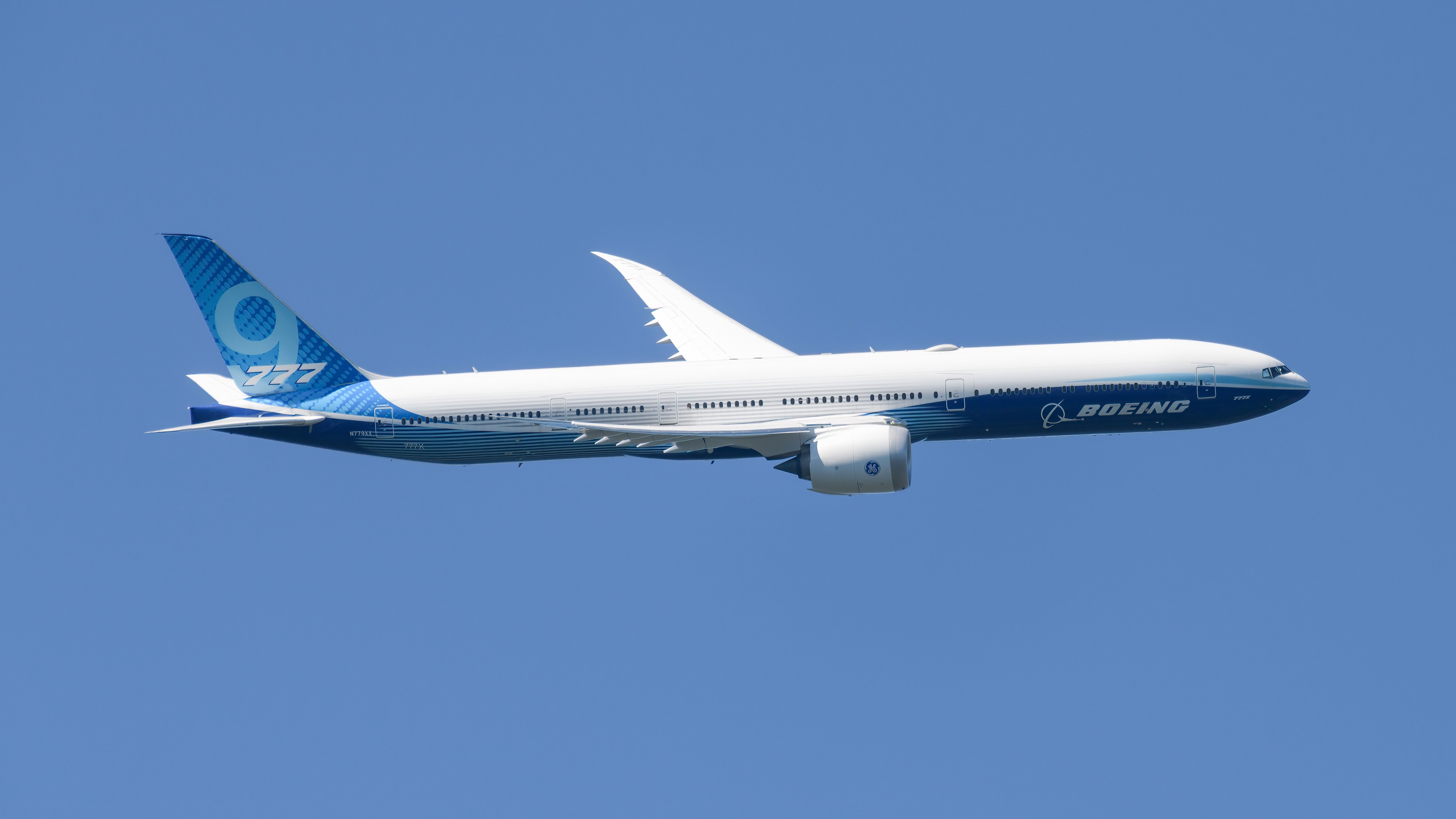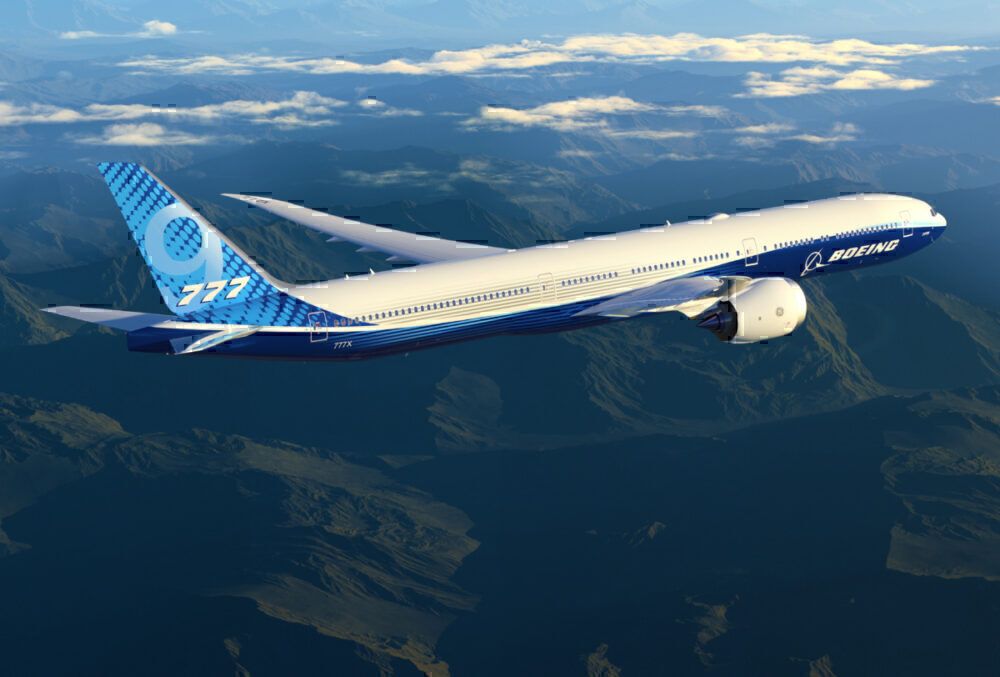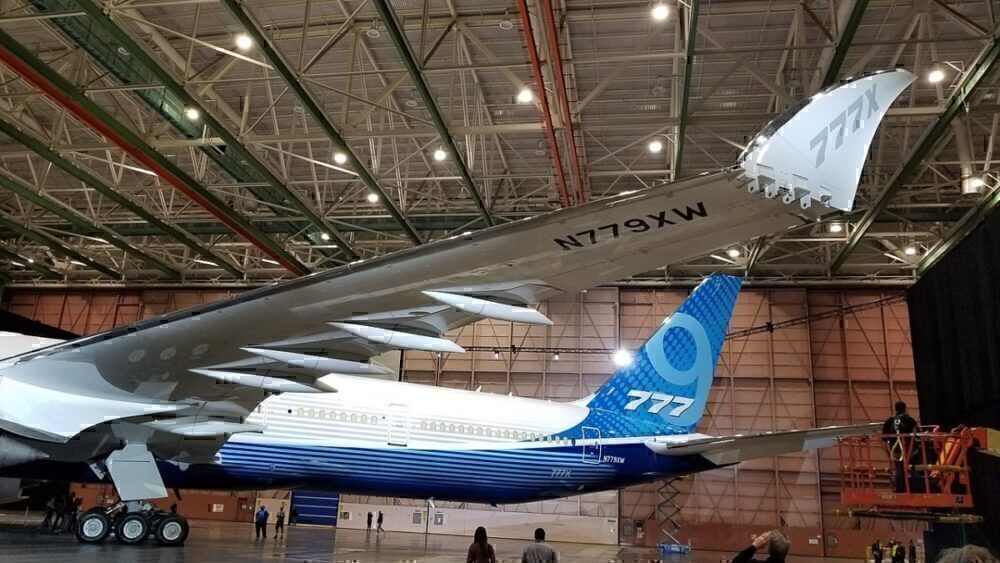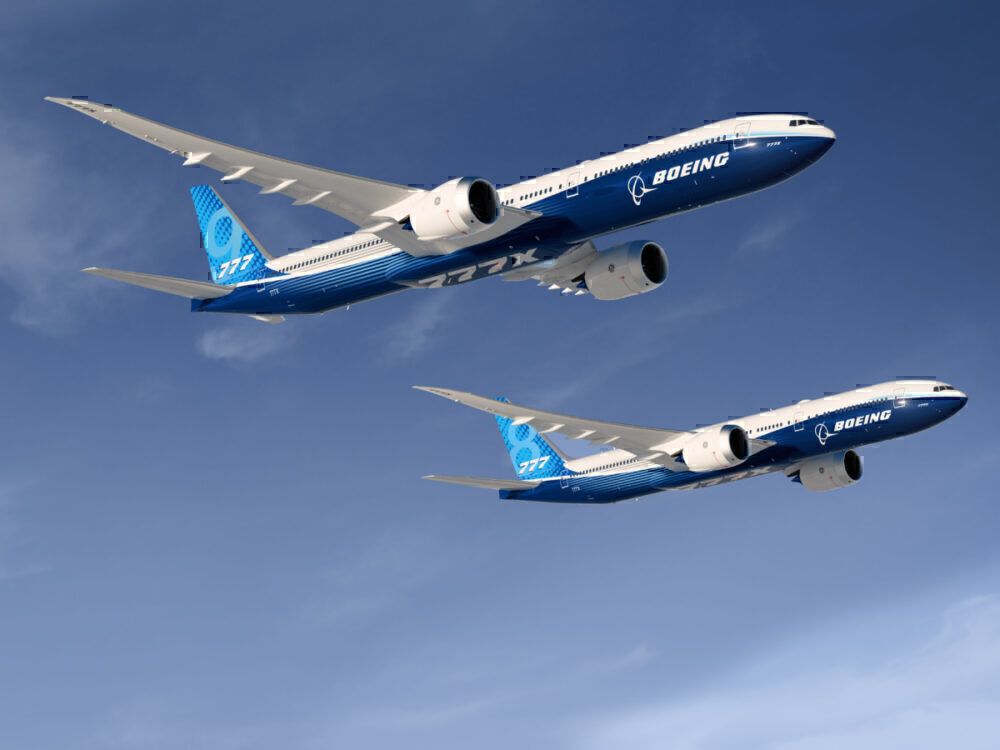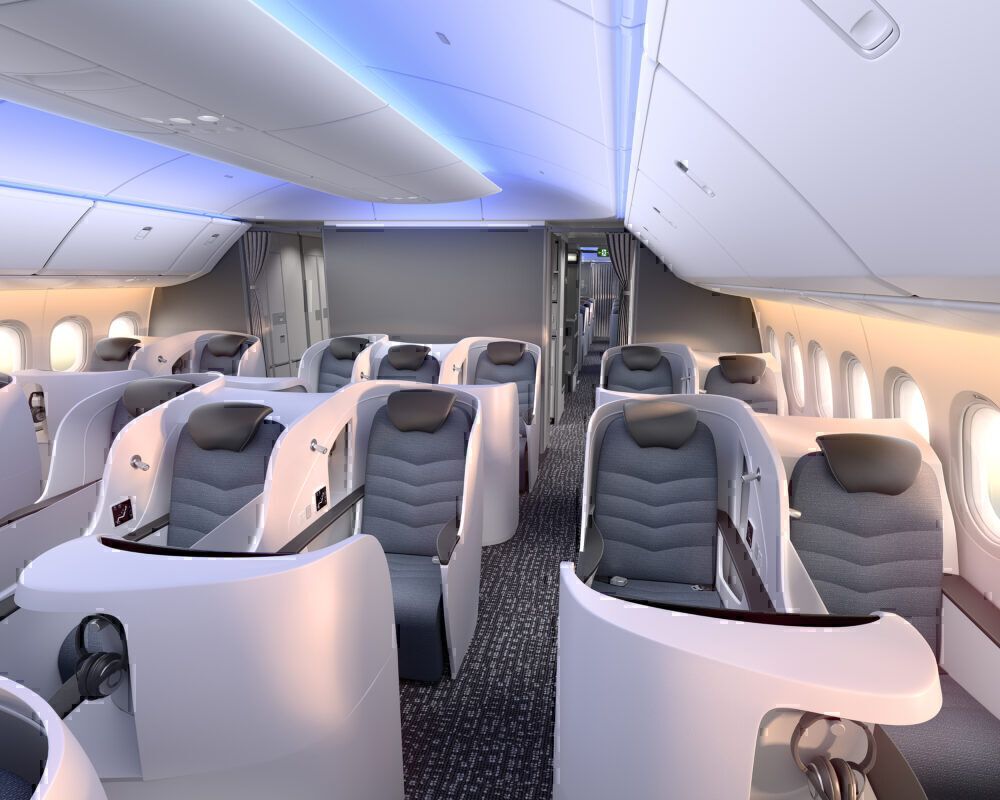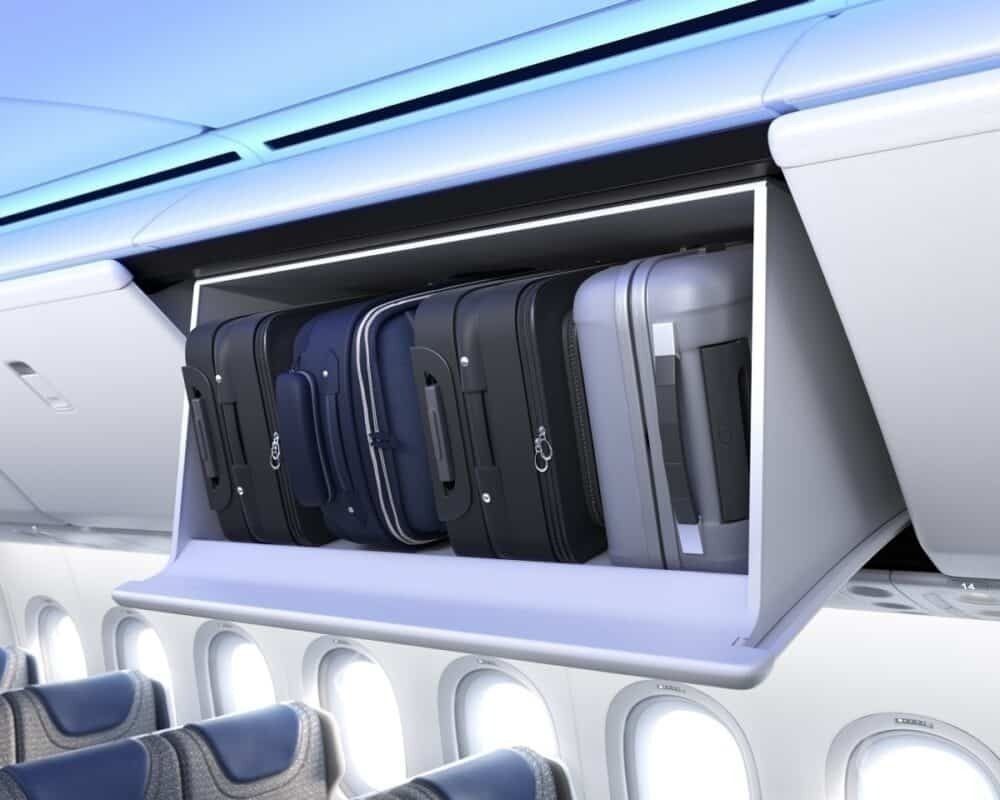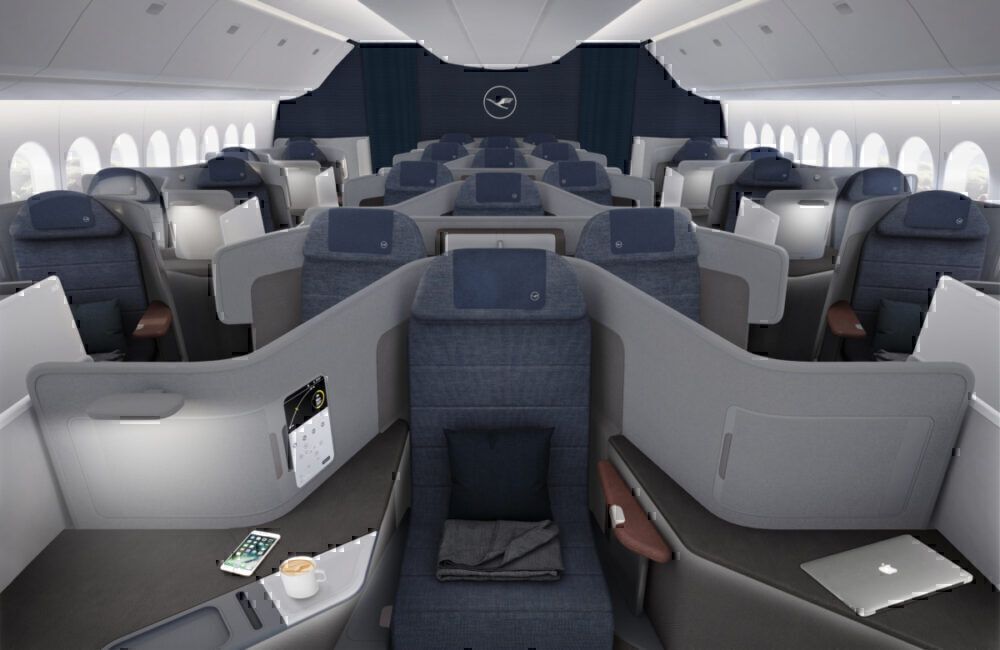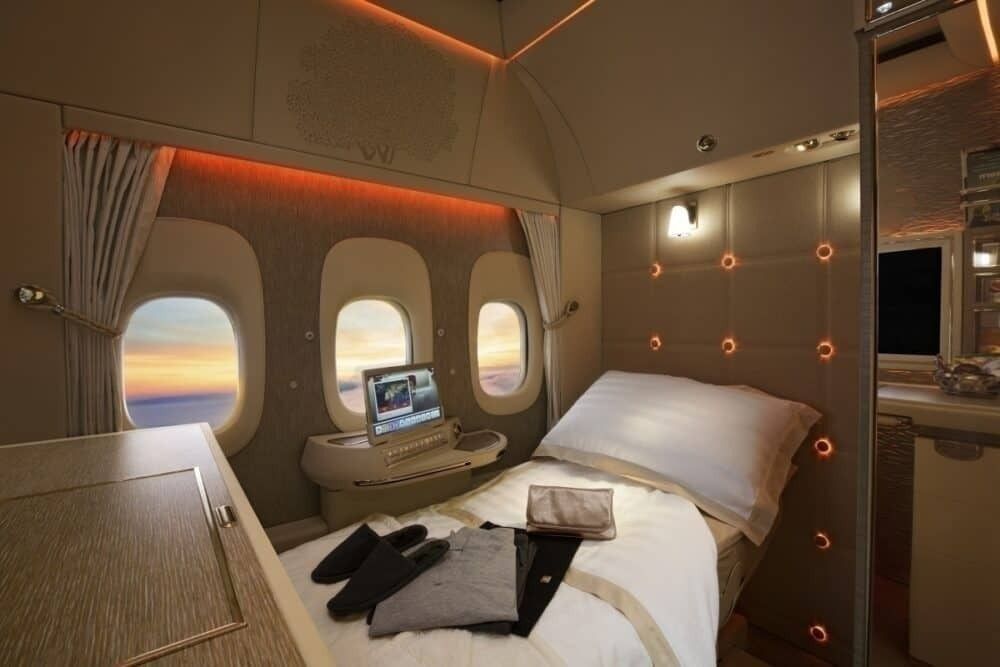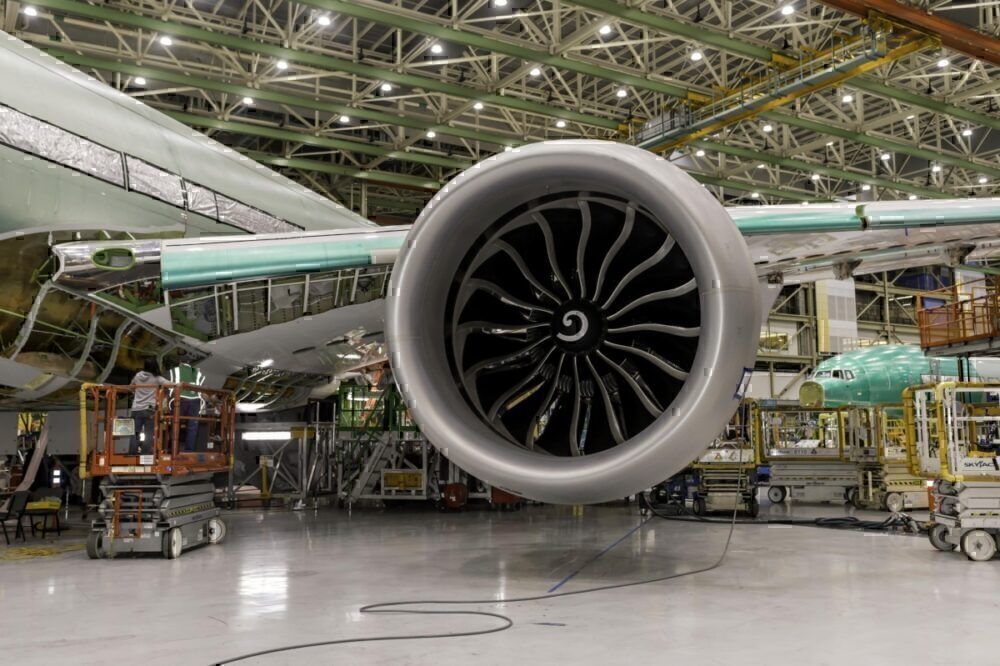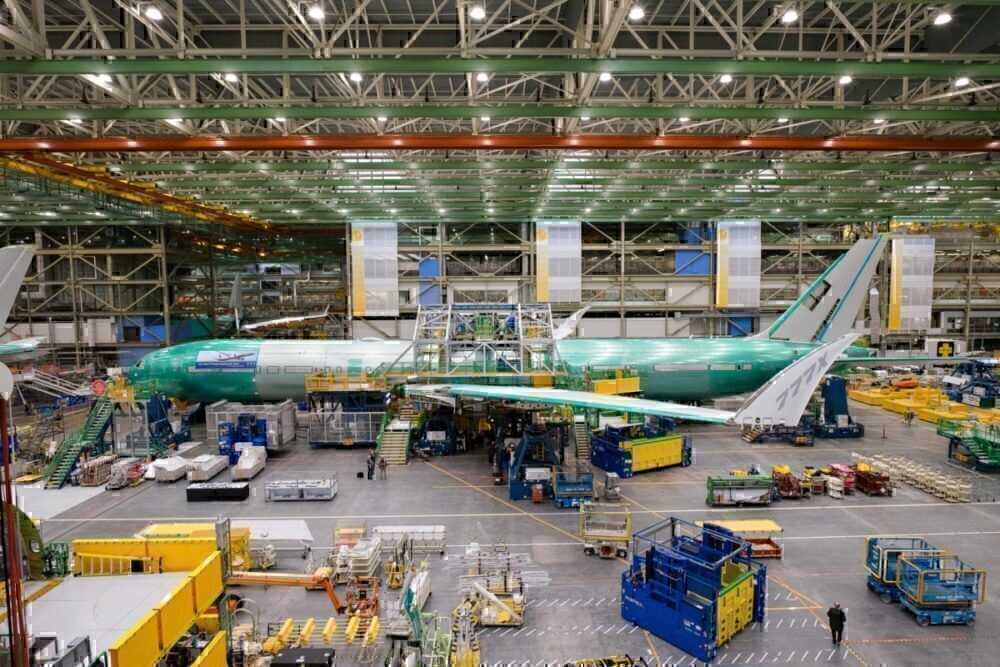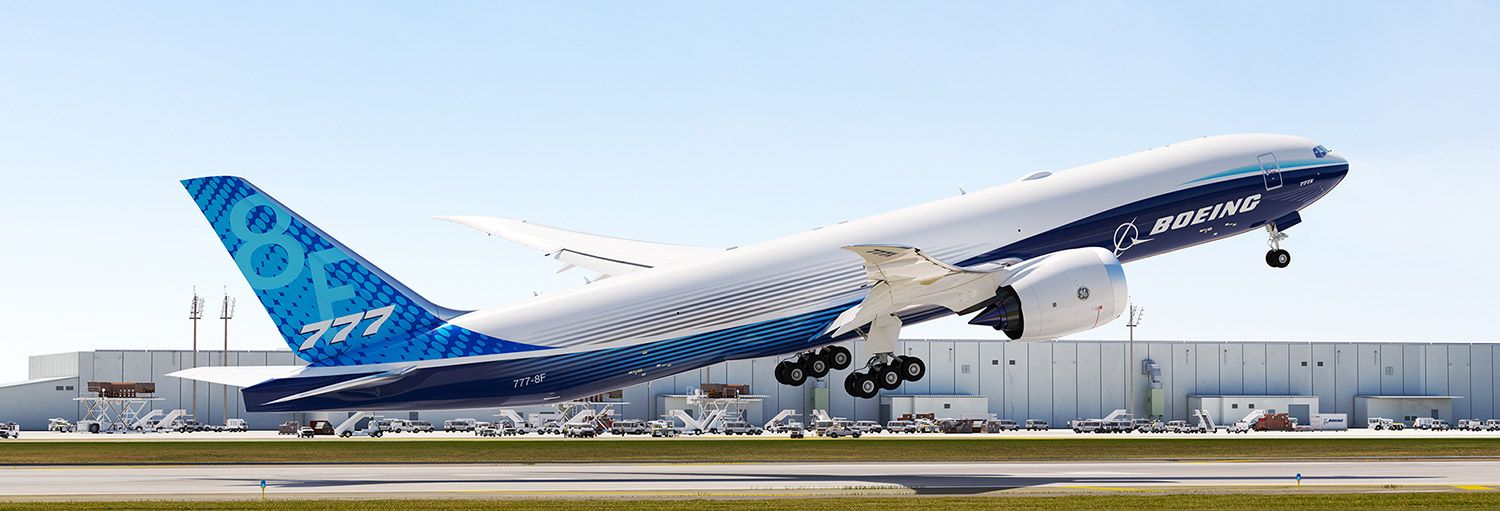Summary
- The Boeing 777X has the highest capacity of any twin-engine aircraft, with a typical two-class seating capacity of 426 passengers.
- The 777X features folding wingtips, allowing for more efficient in-flight operations and access to more airports.
- Boeing has proposed a larger variant of the 777X, the 777-10, which would be the world's longest commercial aircraft. So far, 11 airlines have ordered the 777X.
The Boeing 777X is the latest member of the Boeing 777 family. The third generation of the iconic 777 was launched in 2013, with an estimated entry-into-service date of 2018. The 777X includes two passenger versions: the 777-8 with a passenger capacity of 350 and a stretched 777-9 with a capacity of over 400 passengers. The new-generation General Electric GE9X engines will power the new aircraft.
The aircraft was faced with numerous design and prototyping delays, before Boeing rolled out the first 777-9 model in March 2019. The aircraft performed its maiden flight in January 2020 with deliveries forecasted for 2022. However, Boeing is currently facing testing and production delays, which have further delayed its entry into service until 2025.
The 777X is due to enter service in 2025. It is the highest capacity twin-engine aircraft yet developed and has already proven popularity with airlines, with 453 orders as of December 2023.
This guide takes an in-depth look at the design and interesting characteristics of the 777X. It will pick out some of the most interesting details of the 777X development project, as well as highlighting why it stands out from other aircraft.
The latest Boeing aircraft – the 777X
The Boeing 777 has been the best-selling widebody aircraft to date. It first flew in 1994 and now, 25 years later, it is getting a replacement: the 777X. The latest member of the 777 family, now its third generation, brings with it a lot of improvements. It will carry more people, and fly further than previous versions. And it still has a lot in common with the 777-200 and 777-300, both structurally and operationally.
It offers a lot, and should undoubtedly help Boeing refresh its image after the 737 MAX issues and ongoing problems, and position it well going forward to compete with the A350 and A380.
It has the highest capacity of any twin-engine aircraft
According to Boeing, the 777-9 will offer a typical two-class seating capacity of 426. This is the largest of any twin-engine aircraft to date. For comparison, the A350-900 offers 315 seats and the A350-1000 offers 369. The 777-300 has a capacity of 368.
It is closer to the capacity of some four-engine aircraft. The A340-600 (the largest A340 variant) offers a two-class capacity of 440. And the 747-8 has a typical three-class capacity of 467. The gap between four and two engine aircraft has been narrowing for some time. With ETOPS improvements, there are limited areas where twin-engines cannot fly. And with engine improvements, larger airframes are achieving higher capacities.
The 777 was a significant factor in the demise of the A340. Given the rate at which the other quadjets are being retired, it looks like the 777X will have a similar effect on the remaining four-engine models.
The 777X has folding wingtips
A first amongst commercial aircraft, the 777X will feature wingtips that fold when on the ground. This will bring several advantages. The longer wings allow for more efficient in-flight operations, and folding them on the ground means it can access more airports.
Extended, the wings offer a span of 71.75 meters. Larger wings improve the aerodynamics and efficiency of the aircraft. But, when on the ground, they can be folded to 64.8 meters. This is the same as the 777's wingspan and allows the 777X to use the same taxiway and gate facilities.
It is only the second time that Boeing has redesigned the wing on an existing aircraft. It first did this with the 737, introducing a new wing design for the Next Generation series.
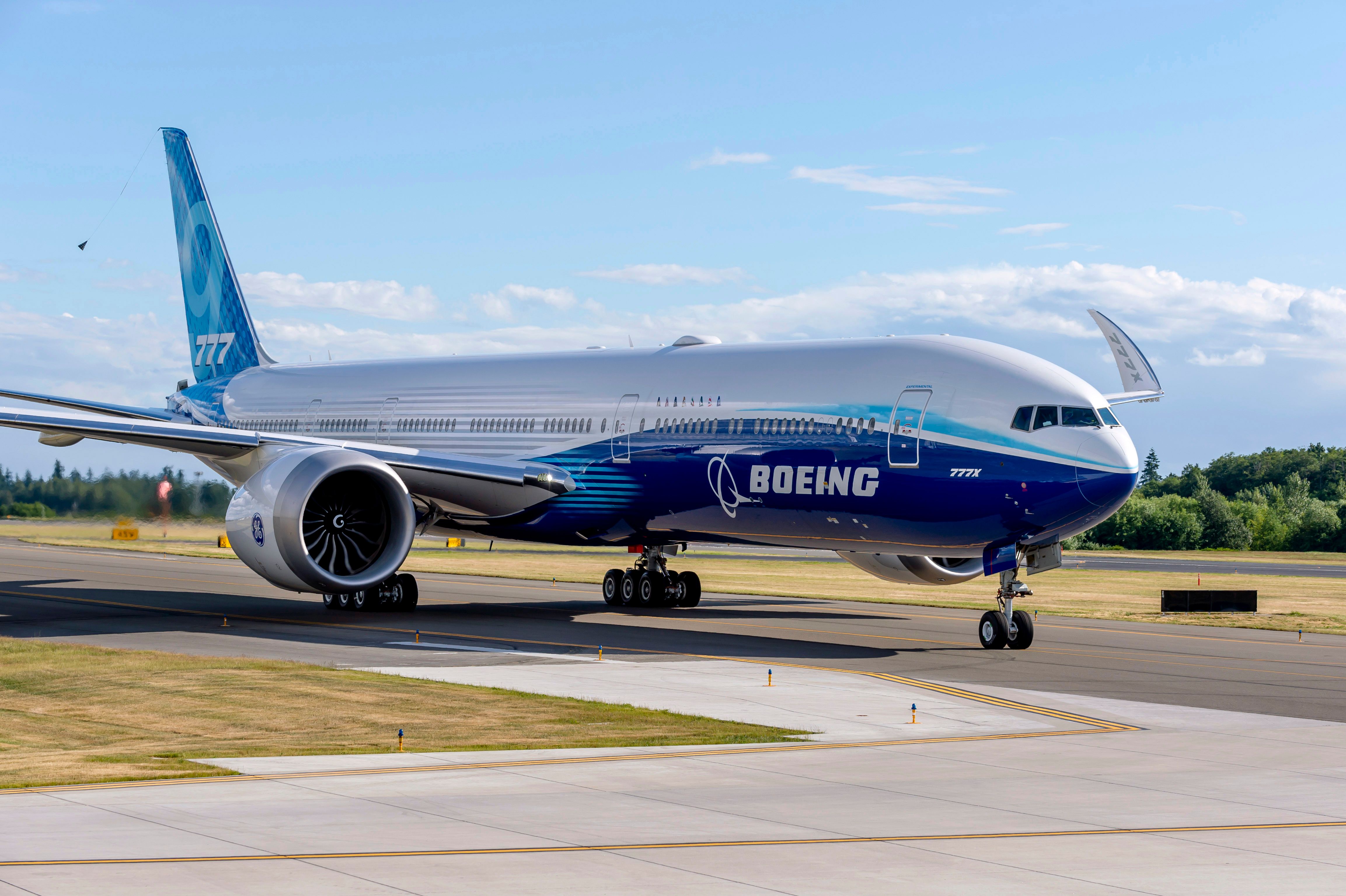
5 Reasons The Boeing 777X Needed To Have Folding Wingtips
The Boeing 777X achieves the best of both worlds with the folding wingtips.One of the difficulties faced by the Airbus A380 was its size and the limits this placed on airport operations. It is categorized as the largest of the six groups defined by FAA's Airplane Design Group (ADG), severely limiting the airports where it can operate. The folding wings keep the 777X in the second-largest group.
There are two versions of the 777X
Boeing is offering two versions of the 777X. The 777-9 is the larger variant and will launch first. This has started test flights and is due to enter service with Emirates in 2025.
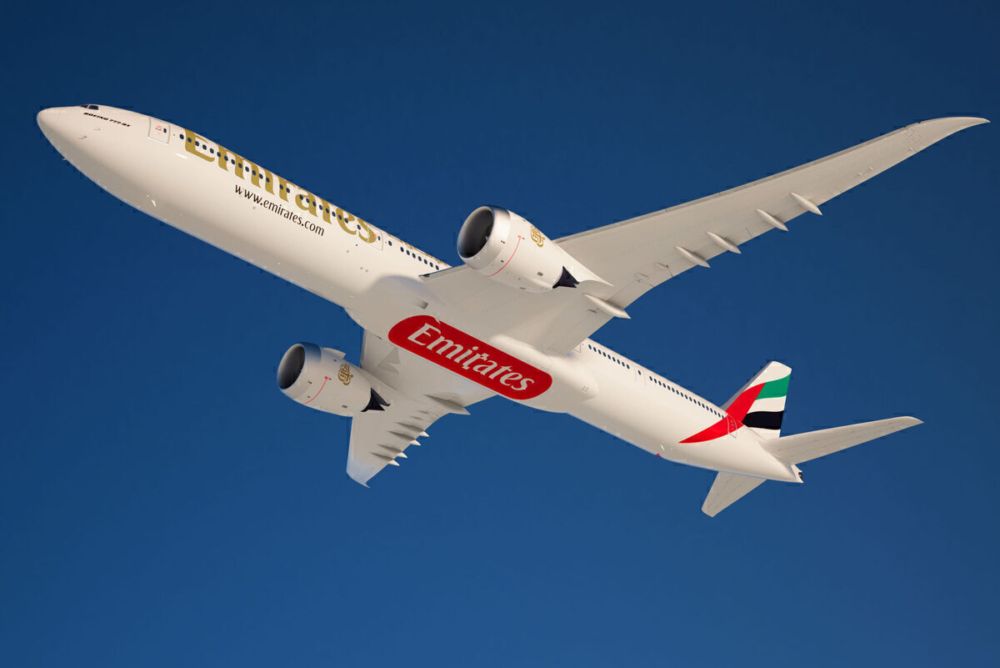
5 Reasons Why The Boeing 777X Is Perfect For Emirates
Emirates is the largest operator of the Boeing 777 family of aircraft.The 777-8 is a shorter version (69.8 meters compared with 76.7 meters). It will have lower passenger capacity but a higher range. Its range of 16,170 kilometers will make it a suitable replacement for the 777-200LR and a strong competitor for the A350-1000 (with a range of 16,100 kilometers).
It should especially appeal to Middle Eastern operators wanting to fly to the US west coast. It has yet to start construction, with the start date of development is yet to be determined.
According to data from Boeing, this is how the two variants compare:
- 777-8: 384 passengers to a range of 8,730 nm / 16,170 km
- 777-9: 426 passengers to a range of 7,285 nm / 13,500 km
Boeing may develop a larger variant
Boeing has also proposed a larger version of the 777X. The 777-10 would be stretched by 3.5 meters over the 777-9, adding four more rows. This would be the world's longest commercial aircraft. It would compete well against the A380 or even a potential further stretch of the A350.
As yet, though, there is no confirmation it will go ahead. Boeing made some comments about it at the Farnborough Air Show in 2016. Boeing Commercial Airplanes chief executive Ray Conner told FlightGlobal:
"We have the ability to do it. If somebody wanted more capacity, that's a pretty straightforward deal for us to do."
The 777X has been purchased by 11 airlines so far
|
Airline |
Total 777X orders |
Aircraft notes |
|
Emirates |
205 |
170 777-9 and 35 777-8 |
|
Qatar Airways |
74 |
40 777-9 and 34 777F |
|
Singapore Airlines |
31 |
All 777-9 |
|
Lufthansa |
27 |
20 777-9 and 7 777F |
|
Etihad Airways |
25 |
17 777-9 and 8 777-8 |
|
Cathay Pacific |
21 |
All 777-9 |
|
All Nippon Airways |
19 |
17 777-9 and 2 777F |
|
British Airways |
18 |
All 777-9 |
|
Cargolux Airlines |
10 |
All 777F |
|
Air India |
10 |
All 777-9 |
|
Silk Way West Airlines |
2 |
All 777F |
Emirates ordered over 200 aircraft
Middle Eastern airline Emirates placed the largest order for the 777X. It ordered 150 aircraft in July 2014 - 35 Boeing 777-8s and 115 Boeing 777-9s. This was not just the largest order for the 777X, but it is one of the largest ever single orders for a commercial aircraft (based on value) at $76 billion list price.
Since then, Emirates has amended its order, switching 30 aircraft to Boeing 787-9 Dreamliners. There have also been discouraging comments from Emirates' President Sir Tim Clark regarding its future needs. According to Executive Traveller, he said in June 2020:
"We are nowhere near confident enough that the economics, the cash flows, the bottom line will put us in a good position to be able to guess if we'll buy a hundred of this or a hundred of that."
It has an aluminum, rather than a composite, fuselage
The 777X will retain an aluminum fuselage, rather than a lighter composite structure as used on the 787, and the competing A350. Boeing has defended this choice (as reported by Bloomberg), explaining that its focus has been on improving the popular 777 and introducing a derivate rather than a brand-new aircraft. This is a strategy it also follows for the 737 family. The metal fuselage of the 777X will be heavier, but this is compensated for by the new engines and wing design.
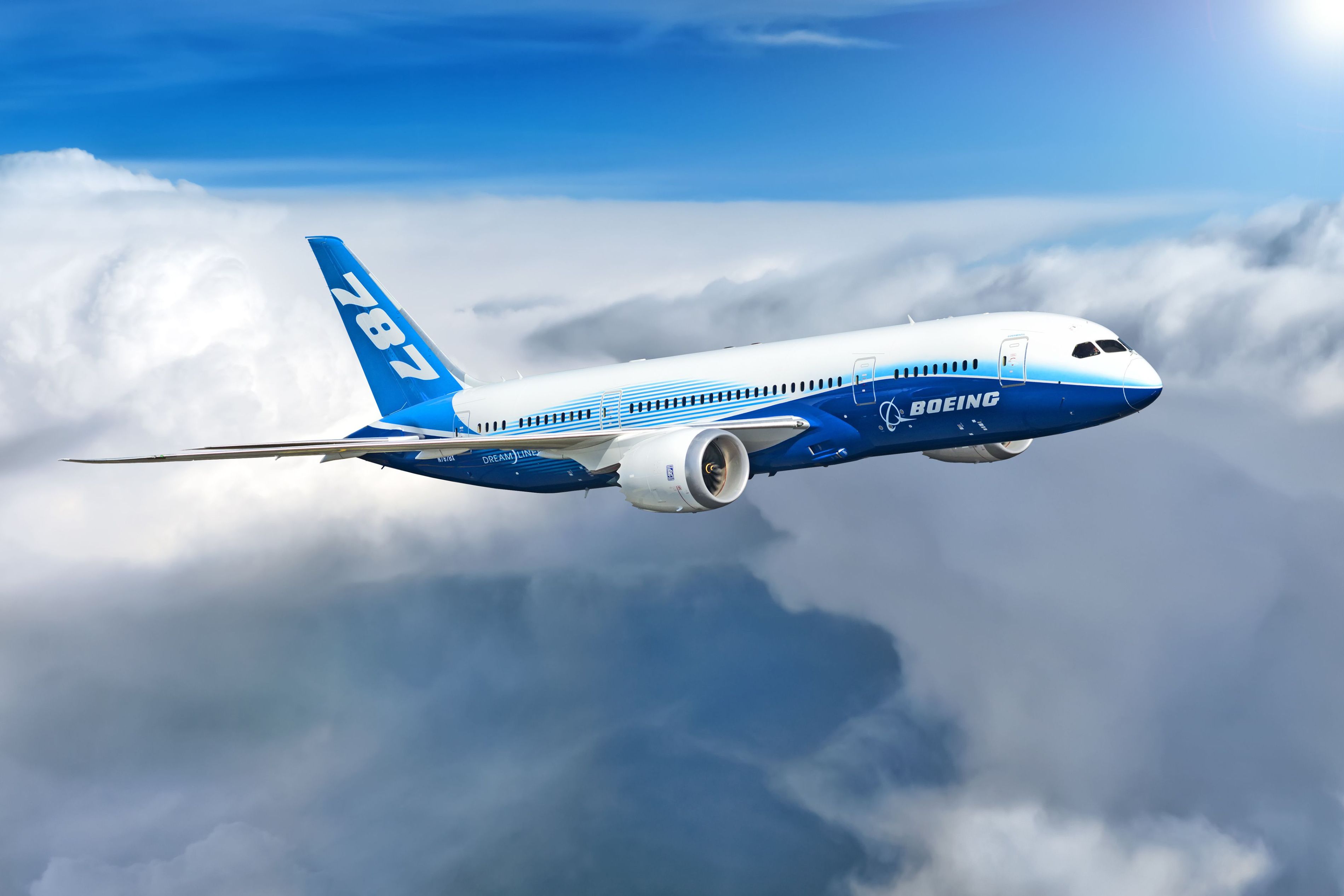
Interesting: How Composite Carbon Fiber Aircraft Can Help Reduce Jet Lag
Carbon fiber aircraft like the 787 and A350 reduce jet lag by increasing cabin pressure and improving humidity.It has a wider cabin than the 777
The cabin width is increased four inches over the 777 through thinner walls and more efficient insulation. This will be especially noticeable in economy and premium economy classes, where the extra width is not enough to add an extra seat, but should allow a bit of extra seat width. Airlines will most likely go with a 10 across economy layout but will have some extra space to use.
Any extra width will help achieve a spacious feeling for passengers. But Boeing hopes to go further with the 777X and improve on passenger feeling and comfort. As reported by CNN, Boeing cabin experience and revenue analysis regional director, Kent Craver explained:
"We've learned a lot since the 777 was first introduced in the 1990s, especially a lot into human psychology during travel… We use lighting and the architecture to create not only physical space, which is finite, but a sense of spaciousness - so on a psychological level."
Large passenger windows
The 777X will feature larger passenger windows than the 777, giving more light in the cabin and better viewing for passengers. On the 777 windows are 140 square inches, and on the A350, they are 125 square inches. The 777X has 162 square inch windows.
The windows are also placed higher in the fuselage to increase viewing. They will also feature the same electronic dimming technology as used on the 787.
They will not be as large, though, as the 787 windows. These are the largest of any commercial aircraft, made possible by the composite fuselage which is more resistant to fatigue.
It will be pressurized to a lower altitude
Raising the pressure inside the cabin has been one of the most significant developments for passengers in recent years. It leads to a more comfortable flight, with fewer jetlag effects. With a simulated lower altitude, the air is denser, and it is easier for the body to oxygenate itself.
Most aircraft cabins are pressurized to 8,000 feet. Boeing lowered that for the 787 to 6,000 feet. It will use similar pressurization for the 777X. This is despite the fact the 777X has an aluminum fuselage as opposed to the composite fuselage of the 787.
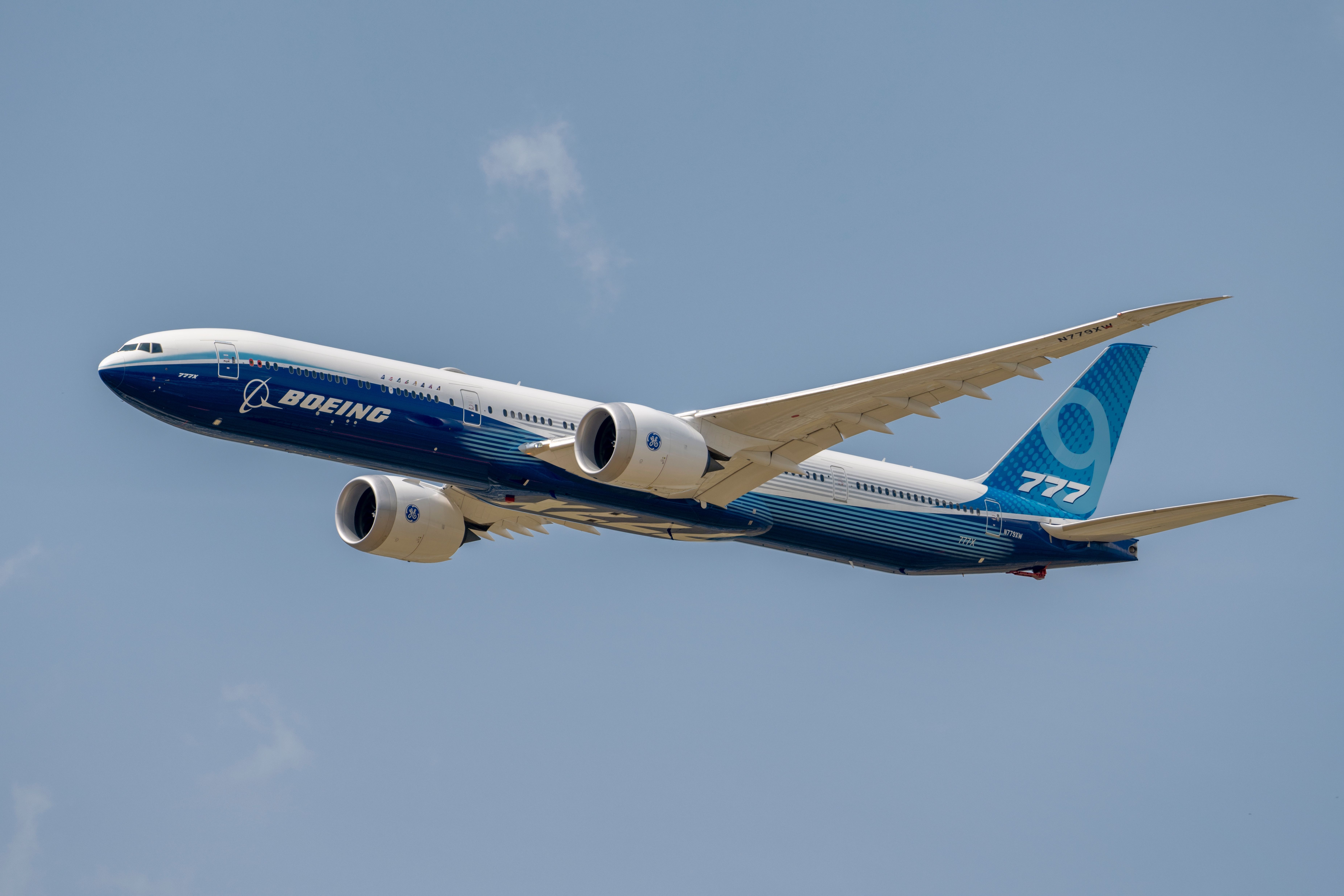
Boeing Says It’s Spent More Time Flight Testing The 777X Than Any Other Aircraft
The 777X has been racking up the hours as its commercial introduction looms in the coming years.In theory, the increased air pressure in the cabin will place greater stress on the aluminum airframe and reduce its service life (which is why we have not typically seen this with other aircraft). Boeing believes though that they can achieve this with the 777X. In reporting by Business Insider, Boeing's Kent Craver explained,
"We also understand the requirements of the lower cabin altitude in terms of cycles and pressures on the fuselage. As a result, we can achieve it with a few local reinforcements and change those loads out to accommodate lower cabin altitude."
More luggage space in the cabin
And one more area that Boeing will aim to improve the passenger experience is with luggage storage. The 777X will add larger overhead bins, allowing luggage to be loaded on its side. This may sound like a small change, but with bags in the cabin increasing as airlines introduce new baggage pricing strategies, having more space, and easier access to luggage during the flight, will be an advantage.
It will be the flagship offering for many airlines
One of the most exciting aspects for passengers will be the flagship status of the 777X with airlines. Many airlines will install their most up to date seating, and some are introducing new premium cabins for it. Some examples include:
- British Airways has confirmed it will install its new Club Suite on the 777X. This is an excellent, upgraded business class that features suite-style seats with partial doors.
- Lufthansa will launch a new business class product with the 777X, featuring open seats but in a more spacious layout than used on other aircraft.
- Singapore Airlines already has some of the best business and first-class products, and there is a possibility that it will develop new ones for the 777X, although this is not yet confirmed.
- Emirates will adopt a similar seat to that used in business class on its A380 aircraft. This is a distinct improvement from its offering on the 777, with 1-2-1 seating as opposed to 2-3-2. It will also debut a new premium economy seat and will use its new 777 first class.
- Qatar Airways is looking at installing an ultra-premium first class. This would only be on some of its 777-9 aircraft, and most likely serve European routes. The launch could coincide with the retirement of its A380s around 2028.
The 777X has the most powerful engines to date
The 777X uses new General Electric GE9X engines. General Electric designed the GE9X engine specifically for the 777X, derived from their GE90 engine used on the 777. It offers 134,300 pounds of thrust, a new world record for a commercial engine, according to a General Electric's report. The previous record was held by the GE90 engine, at 127,900 pounds.
Changes to the GE9X engine include a larger diameter fan with fewer blades (16 instead of 22), use of lighter carbon fiber composite materials, and a higher bypass ratio (offering better propulsion efficiency). These changes help to reduce the weight of the engine and allow for its larger size. These engines are enormous as well as powerful. At 13 feet in diameter, it is wider than the fuselage of the Boeing 737.
It is more efficient than other aircraft
Despite the largest engines, highest capacity, and huge range, the 777X will be an extremely efficient aircraft. It offers a cost per seat 13% lower than the 777-300ER and 33% lower than the 747-400 (according to an analysis by The Air Current).
It is hard to compare efficiency with other aircraft until it is in service. Boeing, however, claims that the 777-8 will offer 4% lower operating costs than the A350-1000 and the 777-9 up to 11% lower costs. Forbes, in its analysis of this, points out that this becomes more significant if airlines adopt the higher capacity and higher cargo capacity model and think in terms of a carbon footprint per capita.
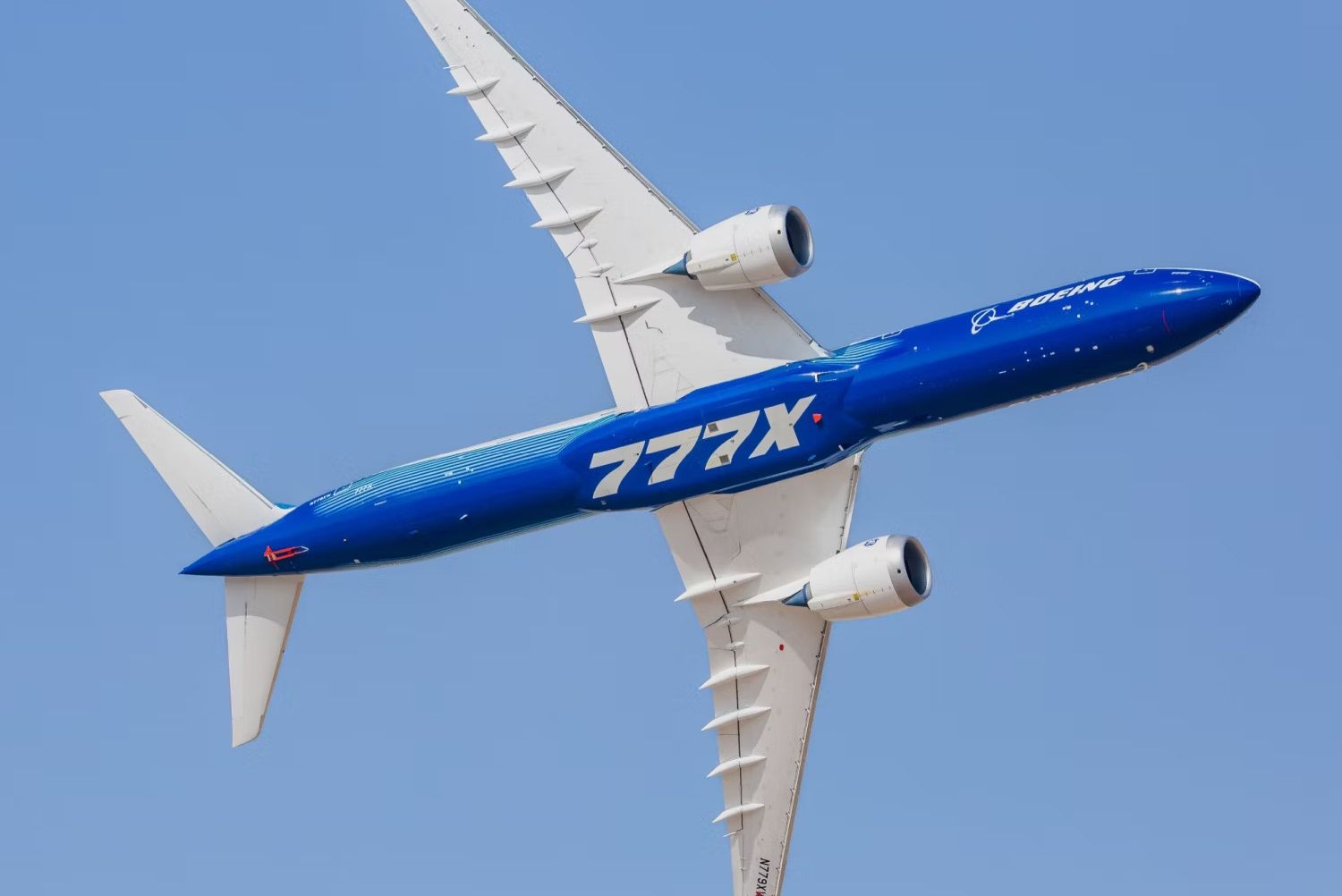
Will The Boeing 777X Be The Last Airliner Of its Kind?
As the industry moves toward smaller planes for longer flights, could the 777X be the last of its kind?But Simple Flying did look at this previously and found (based on predicted range and fuel burn) the two aircraft would have similar fuel burn per seat. The real test of this, however, will come later.
It is expensive
All these features, however, come at a price. The 777-9 lists at $425.8 million, compared to $361.5 million for the 777-300ER, and $418 million for the 747-8. It is Boeing's most expensive aircraft to date.
But Airbus takes top place for the most expensive aircraft, with the A380 list price of $445.6 million. More importantly, though, the A350-1000 comes in lower at $366 million.
Of course, most airlines negotiate prices lower than the list price. With Airbus, this is often around 50% lower, as Simple Flying looked at previously.
Early testing did not go too well
Testing of the 777X began in 2019, with the first test flights taking place in early 2020. These flights were delayed after problems with the GE9X engines, and issues with structural testing. In September 2019, the fuselage was ripped apart during stress testing. This occurred close to the maximum stress levels (99% of the target), and the rapid depressurization of the fuselage caused the damage. The test aircraft was written off, but the test does not need to be repeated, and Boeing claims it did not have an impact on schedules.
There could be a freighter version of the 777X
In a communication in 2015, however, Boeing discussed a possible freight version based on the 777-8 airframe, 18-24 months after the passenger 777-8. There is support from airlines too. At the Paris Air Show in 2019, Qatar Airways expressed its desire for a 777X freighter to be made available, and its willingness to be the launch customer (as reported by FlightGlobal). Qatar Airways chief executive Akbar Al Baker explained his thinking:
"By 2025, our initial freighters will be getting about 10 years old, so we will need to replace them. Hopefully, Boeing will launch a 777X-based freighter."
Boeing launched the 777-8F in January 2022.
Boeing already dominates the cargo market, with the 777 and 747 freighter versions. A logical expansion would be to do so for the 777X, with all of its engine and efficiency benefits.
There is certainly space in the market. In reporting in the cargo industry publication Cargo Forwarder, Boeing claims that an additional 1,040 widebody freighters will be needed in the coming 20 years.
What do you think of the 777X? Are there any more details you would like to share or find out more about? Let us know in the comments.

